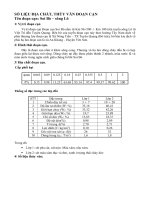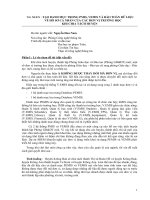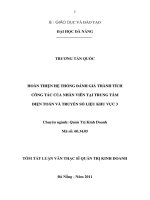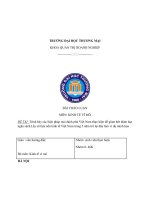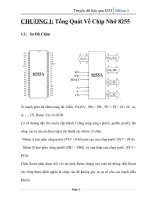Ch3 1 v1 TRUYỀN SỐ LIỆU VÀ MẠNG
Bạn đang xem bản rút gọn của tài liệu. Xem và tải ngay bản đầy đủ của tài liệu tại đây (833.44 KB, 51 trang )
Chapter 3
Data and Signals
3.1
Copyright © The McGraw-Hill Companies, Inc. Permission required for reproduction or display.
Note
To be transmitted, data must be
transformed to electromagnetic signals.
3.2
3-1 ANALOG AND DIGITAL
Data can be analog or digital. The term analog data refers
to information that is continuous; digital data refers to
information that has discrete states. Analog data take on
continuous values. Digital data take on discrete values.
Topics discussed in this section:
Analog and Digital Data
Analog and Digital Signals
Periodic and Nonperiodic Signals
3.3
Analog and Digital Data
3.4
Data can be analog or digital.
Analog data are continuous and take
continuous values.
Digital data have discrete states and take
discrete values.
Analog and Digital Signals
•
•
•
3.5
Signals can be analog or digital.
Analog signals can have an infinite number
of values in a range.
Digital signals can have only a limited
number of values.
Figure 3.1 Comparison of analog and digital signals
3.6
3-2 PERIODIC ANALOG SIGNALS
In data communications, we commonly use periodic
analog signals and nonperiodic digital signals.
Periodic analog signals can be classified as simple or
composite. A simple periodic analog signal, a sine wave,
cannot be decomposed into simpler signals. A composite
periodic analog signal is composed of multiple sine
waves.
Topics discussed in this section:
Sine Wave
Wavelength
Time and Frequency Domain
Composite Signals
Bandwidth
3.7
Figure 3.2 A sine wave
3.8
Figure 3.3 Two signals with the same phase and frequency,
but different amplitudes
3.9
Note
Frequency and period are the inverse of
each other.
3.10
Figure 3.4 Two signals with the same amplitude and phase,
but different frequencies
3.11
Table 3.1 Units of period and frequency
3.12
Example 3.1
The power we use at home has a frequency of 60 Hz.
The period of this sine wave can be determined as
follows:
3.13
Example 3.2
The period of a signal is 100 ms. What is its frequency in
kilohertz?
Solution
First we change 100 ms to seconds, and then we
calculate the frequency from the period (1 Hz = 10−3
kHz).
3.14
Frequency
•
•
•
3.15
Frequency is the rate of change with respect
to time.
Change in a short span of time means high
frequency.
Change over a long span of
time means low frequency.
Note
If a signal does not change at all, its
frequency is zero.
If a signal changes instantaneously, its
frequency is infinite.
3.16
Note
Phase describes the position of the
waveform relative to time 0.
3.17
Figure 3.5 Three sine waves with the same amplitude and frequency,
but different phases
3.18
Example 3.3
A sine wave is offset 1/6 cycle with respect to time 0.
What is its phase in degrees and radians?
Solution
We know that 1 complete cycle is 360°. Therefore, 1/6
cycle is
3.19
Figure 3.6 Wavelength and period
3.20
